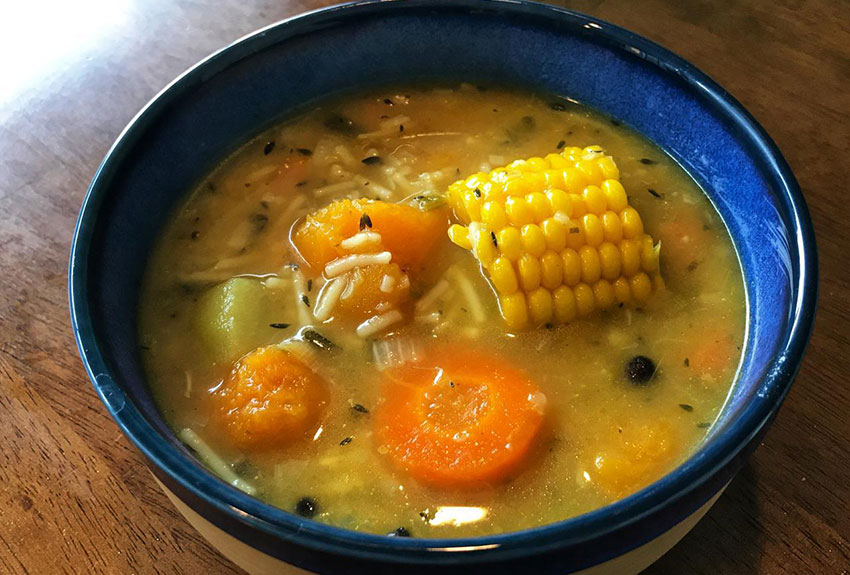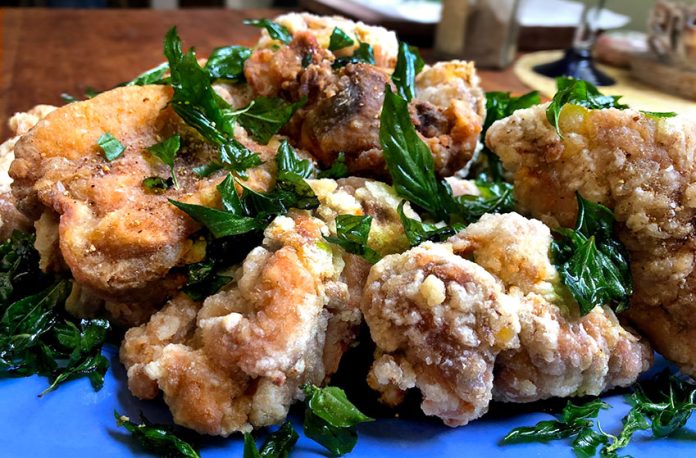Nick Gilman gives me the frazzled half-smile I sometimes see on new mothers – happy, exhausted, a tinge of anxiety. This is the opening night of his Moroccan restaurant. Tomorrow night it will close.
That’s because this no name pop-up restaurant only runs about two days a month in an artist’s studio space in Mexico City’s hip Colonia Roma.
It’s mid-February, so Gilman and partner Sebastian Manterola can be pretty sure there won’t be the deluge of rain the city gets from May to October. The rooftop tables are set for 30-plus diners and a simple bar is loosening up all the strangers about to sit down to a meal together.
If you haven’t been to a pop-up yet, you are hopelessly out of the loop, as the concept is now so solidly enmeshed in the gastronomic foodscape that you can find how-to posts on creating your own, as well as on leveraging your pop-up for investment in an eventual bricks-and-mortar spot. The exclusive and ephemeral meal offered by restaurants only open for a night or two appeals not only to the current obsession with “food experiences” (preferably those that are Instagram-friendly) but also the incredible sense of FOMO (fear of missing out) we are both afflicted with and hope to generate in others through our social media.
Often, a pop-up is a kitchen takeover from one chef by another, but its myriad of forms means it doesn’t have to be. Gilman is a well-known Mexico City food writer who was delving into Mexican food long before it was literally on everyone’s lips. He and Manterola, a Mexico City native who until 2018 was a graphic designer by day, dedicated home cook by night, had in the past each separately shrugged off the idea of being chefs, even though they are clearly obsessed with food.

“In my case,” says Gilman, “I’m older and so it wasn’t a cool thing to do back them. Nobody did that. I knew one girl from art school that went to The Culinary Institute and I had no idea why or what she was doing there. It would have never occurred to me, even though I’ve been fascinated by food since I was six.”
“To be honest,” continues Manterola, whose family has often asked him why he didn’t go to culinary school, “even now that I want to cook for a living, it’s never been my intention to be a chef. I like regular food, the whole chef scene is just not for me. I just want to be a cook.”
As friends cooking meals in Gilman’s kitchen, it occurred to these two to find a way to share the food they love with the public, but neither wanted the stress and creative restrictions of a regular restaurant. The pop-up seemed a logical choice.
“We want to make food we love, food we are excited about,” says Manterola. “With a restaurant you are stuck doing the same thing all the time, not with this.”
The concept of pop-ups in a country where random street stands burst through the sidewalk cracks like dandelions is not radical. But by calling these temporary dinners pop-ups, they suddenly have cachet with Mexico City foodies.
“It’s not that the pop-up trend came late to Mexico City,” says Manterola. “I know guys that have been doing pop-ups for 15 years, but they weren’t called pop-ups. The moment they started calling it that, and it reminded people of this culture of young chefs in Portland and Paris, then it became fashionable and something everyone wanted to be involved in.”

The pure flexibility of the concept – from a backyard barbecue to a private fine dining room in a swanky boutique hotel – is a big part of the appeal for the cooks I talked to. It also means there is a pop-up for everyone in Mexico City.
Manterola and Gilman are trying to maintain a sense of flavor over finery, pleasant over pretentious, home cooking over haute cuisine. None of which should be misrepresented to mean that they don’t bring it to every meal they make. The general bent of their dinners is world cuisine (one night three kinds of fried chicken from around the world; another, Italian-American favorites; the night I went, a Moroccan feast) at a price point that’s accessible (about US $35) and in an ambiance that doesn’t feel precious but instead like a nice adult dinner party that’s going to get even more interesting as the alcohol flows.
A step in an even more casual direction is the La Xaymaca (pronounced za- Mai-Ka) project, run by Jamaican transplant Theresa Barrett. With usually under a dozen guests, sometimes as few as four, Theresa invites diners right into her living room lined with a motley crew of potted plants against the floor-to-ceiling windows.
Barrett is shy about her cooking, even though the delicate spice of her dishes invokes the island in a way that will have you checking flights on your way home. She explains that her food represents the history of her country, that of slaves from across the African continent each bringing their unique culinary history to the island. And there is also her own history, the smells and flavors of her mother’s kitchen in Kingston.
“For me personally, a good meal has a story and a journey,” she says. When her journey led her to Mexico City, one of the biggest holes in her life was food from home. So she started doing a dinner here and a dinner there, and people clamored for more.
While there is still plenty of gramming and influencer posturing, an overwhelming majority of Mexico City pop-ups have the added element of offering cuisines that weren’t available in the city just five short years ago, and even now are deliciously elusive. Mexicans, with their deeply rooted culinary past, have always been somewhat food obsessed, but nowadays they are looking outward beyond their region, and the pop-ups are scratching the foodie itch.

“That’s what I’ve seen changing in the 10 or 12 years that I’ve been writing about food here,” says Gilman. “People are both more interested and more knowledgeable about other kinds of cuisine. People are starting to care more.”
“And more open-minded to try things,” adds Manterola.
Lest you think that pop-ups here don’t have the star power and chef worship that they do in the United States, that Luca Pronzato is bringing his international project to Mexico City in April of this year should be confirmation that Mexico City is officially on the pop-up map. In collaboration with the Mexican hospitality group Grupo Habita, the ONA Le Toit pop-up will run from April till June of this year and feature rising young chefs from across the globe.
Not that the city needs big name foreigners to do our cooking. We have dozens of world-renowned chefs right in our midst, ahem — Ricardo Muñoz, Enrique Olvera, Monica Patiño, Gerardo Vazquez, Eduardo García, Elena Reygadas …
Partners Saqib Keval and Norma Listman of Masala Y Maiz fame basically dragged their popular restaurant back into being after it was shuttered by city officials by doing pop-ups all over the city, including in collaboration with the last two names on that list. And Yolcan, a local community-supported agriculture project, has hosted about a dozen Chef Semilla pop-ups that have featured Muñoz, García and others.
Yolcan, which works with organic farmers in the city’s southern canals, provides all the aforementioned restaurants (and many more) with organic produce and specialty items. Their pop-up dinners not only feature fancy flavors, but also draw attention to the importance of local food sourcing and the ecological fragility of the city’s chinampa (island farm) ecosystem.
The Sexto Colectivo was one of their invited guest chefs, and for cerebral eaters, there could be nothing more inviting than one of this group’s prettily plated dives into food concepts and ingredients (themes like fermentation or wild mushrooms) that end up as unforgettable multi-course menus. Colectivo members come from a variety of backgrounds – PR, marketing, sustainability, even a pharmaceutical researcher – all led by the mild-mannered Juan Escalona, whose resume includes working in the kitchen of NOMA in Copenhagen, Maximo Bistrot and Pujol in Mexico City, getting a bachelor in genomic science, and a master’s in history and philosophy from the University of Leeds in London. They take their food seriously; it’s a heady dinner.
Then there’s Bacal, one of the more eclectic experiences in the Mexico City pop-up world. Run by the affable Eric Namour, a Lebanese transplant to Mexico via Martinique via Italy via London via Canada, this tiny bar and restaurant sits unassumingly on one of the city’s most bustling avenues and while it has the veneer of hipster, Namour sweeps away any pretension when you walk through the door. Every few weeks he invites a guest chef or cook (“I actually prefer when people cook that aren’t cooks,” he admits) that takes over his kitchen, serving a buffet-style meal of any type of food they fancy at a delightfully moderate price (about 10 bucks a person).
Added to the delicacies are the homemade cocktails by his baby-faced barmaster Axel Bernardino, and dozens of natural wines which are Namour’s weakness.
The randomness of this style of dining does mean that you have to follow these folks on social media to fill in the whens and wheres of dinners. It also means that if you eat something mind-blowing you might never be able to find it again … but’s just all the more reason to eat up.
Mexico News Daily
